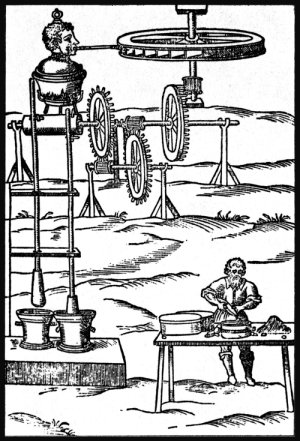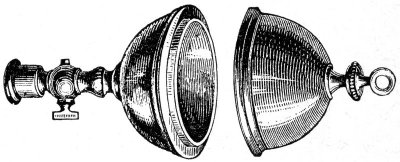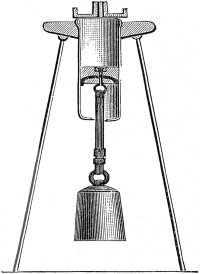You might say that we invented steam in the glorious seventeenth century -- the same century in which we invented modern science. Copernicus, Kepler, and Galileo set the stage for a new interest in atoms. For celestial mechanics could be applied to the movement of gaseous atoms as well as to planets. And, once we had mechanical means for describing atomic movement, alchemical science began its slow fall from grace.
French philosopher Pierre Gassendi was a key player in the rebirth of atomism. Gassendi was 28 years younger than Galileo. As he began studying Aristotelian science, the noose of the Inquisition had yet to tighten around Galileo's neck. Galileo's earlier criticisms of Aristotle were well known -- even accepted. Now Gassendi picked up his own attack on Aristotelian science. But he had an edge; he believed in experimental proof.
Galileo had argued that, if you drop an object within some moving framework, it shares the motion of that frame. So Gassendi arranged to have a weight dropped from the mast of a moving ship. The weight landed at the foot of the mast -- not behind it, as it would've if the fall were independent of the ship's movement. That gave enormous validity to non-Aristotelian dynamics. If Galileo had done that experiment, it might've saved him from a lot of his troubles.
Gassendi did much more. In particular, he said that all material phenomena must arise from the indestructible motion of atoms, and he used that fact to explain air pressure.
 A curious sidelight on Gassendi is that he influenced Cyrano de Bergerac, and Cyrano became an early science fiction writer. Cyrano dramatized the efficacy of steam in his book, Voyage to the Moon. His hero made several attempts to get to the moon. In one of them, he surrounded his body with glasses of morning dew. When the sun warmed the dew and drew it up heavenward, it drew Cyrano's space traveler along with it.
A curious sidelight on Gassendi is that he influenced Cyrano de Bergerac, and Cyrano became an early science fiction writer. Cyrano dramatized the efficacy of steam in his book, Voyage to the Moon. His hero made several attempts to get to the moon. In one of them, he surrounded his body with glasses of morning dew. When the sun warmed the dew and drew it up heavenward, it drew Cyrano's space traveler along with it.
Don't laugh. That bit of fantasy came about because many people were viewing gases and vapor with new eyes. Two Gassendi contemporaries proposed means for pumping water out of closed containers by introducing pressurized steam. They concocted rudimentary steam pumps.
Another invention was wildly ahead of its time: As you doubtless know, modern steam turbines use high-velocity steam jets, acting upon blades mounted around the rim of a rotating turbine wheel. Steam turbines are close kin to windmills or waterwheels. In 1629, Giovanni Branca presented a clear drawing of a steam turbine. It was a sufflator blowing steam onto blades of a turbine wheel, which, in turn, drove a pair of pestles. Of course it was only a concept; he didn't actually build it.
The person who really put flesh and blood upon the notion that gases harbor material force was Otto von Guericke, an influential citizen of Magdeburg in Saxony. Born in 1602, he became a diplomat, then, in 1647, mayor of Magdeburg. That was also the year when he became fascinated by Galileo's and Torricelli's work with air pressure. Torricelli, had worked with Galileo, and he'd invented the barometer. We name the unit of atmospheric pressure -- the Torr -- after him.
Von Guericke soon invented his own vacuum pump, and what he did with it was spectacular. By 1657 he was able to give the citizens of Magdeburg a remarkable demonstration of the hidden potential of the atmosphere. He carefully machined two hollow hemispheres, twenty inches in diameter. When their smooth flanges were joined, they formed a single tightly-sealed sphere.

The Magdeburg Sphere

Another von Guericke experiment in which he lifted a heavy weight by drawing a vacuum in a cylinder into which was fitted a piston.
[Both drawings are given by J. D. Steele, Fourteen Weeks in Physics. (New York: A. S. Barnes & Company, 1878).]
He pumped the air out of the sphere so the force of the atmosphere alone now held the two halves together. Then he harnessed sixteen horses, eight on each side, and let them try to pull the halves apart. They couldn't do it; it would've taken a force over two tons to break the sphere open.
Von Guericke did more demonstrations, but, while they were equally revealing, what lingered was the image of sixteen horses vainly trying to separate two hemispheres held together by airy emptiness. It was theater that could no longer be ignored.
Von Gericke accomplished what all before him had not: Once we'd seen horses defeated by the enormous strength of fragile vapor, gases could never again be underestimated. After von Guericke, it was only a matter of time before someone would take the next step and create a work-producing machine, an engine, driven by steam.
- B. Rochot, Gassendi (Gassend), Pierre. Dictionary of Scientific Biography, Vol. V (C.C. Gilespie, ed.) (New York: Charles Scribner's Sons, 1972).
- For more on Cyrano's science fiction, see: W. von Braun and F. I. Ordway, III, History of Rocketry & Space Travel. (revised ed.) (New York: Thomas Y. Cromwell Co., 1969), or read Cyrano himself in: Cyrano de Bergerac, Voyages to the Moon and the Sun. (tr. Richard Aldington) (New York: The Orion Press, 1962.). See also Cyrano's The Other World or the States and Empires of the Moon on line at: www.bewilderingstories.com/special/index.html
- It is normal to mention ideas contemporary with Gassendi in any history of steam engines. They were Della Porta's and de Caus's conceptions of steam pumps. See e.g.: H. W. Dickinson, A Short History of the Steam Engine. (Cambridge: At the University Press, 1939) or R. H. Thurston, A History of the Growth of the Steam Engine. Port Washington, NY: Kennikat Press, 1907, 1939.)
- C. A. Ronan, The Shorter Science and Civilisation in China: An abridgement of Joseph Needham's Original Text. (Cambridge: Cambridge University Press, 1994.)
- L. Branca, Le Machine. (1629.) The Max Plank Institute has graciously put Branca's full text with images in the public domain. See: echo.mpiwg-berlin.mpg.de/content/historymechanics/archimdesecho
- F. Krafft, Guericke (Gericke), Otto Von. Dictionary of Scientific Biography, Vol. V (C.C. Gilespie, ed.) (New York: Charles Scribner's Sons, 1972).